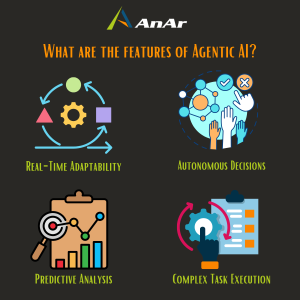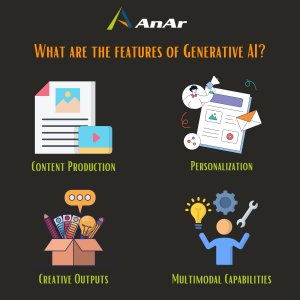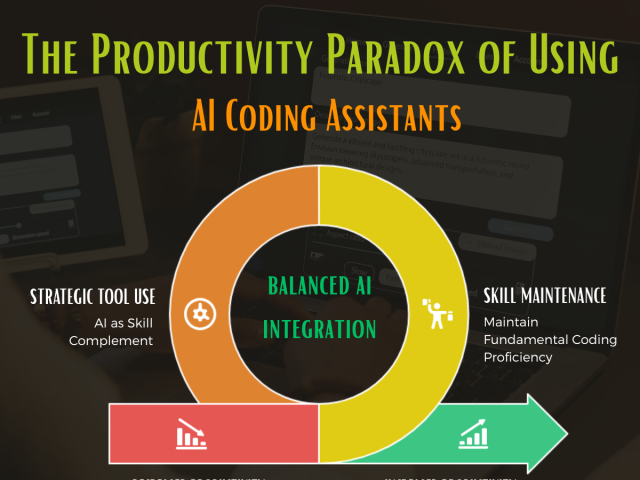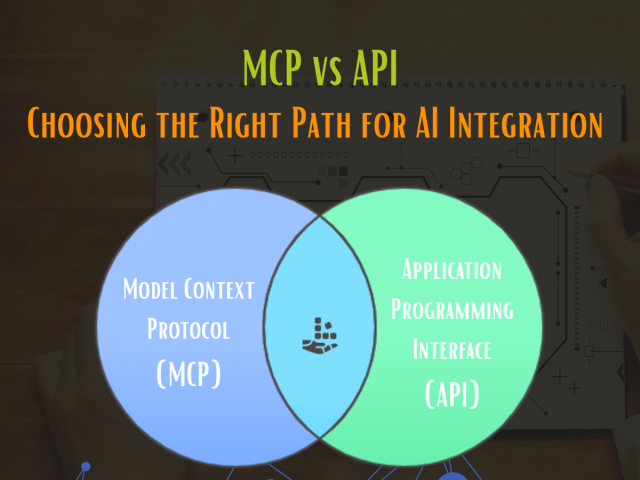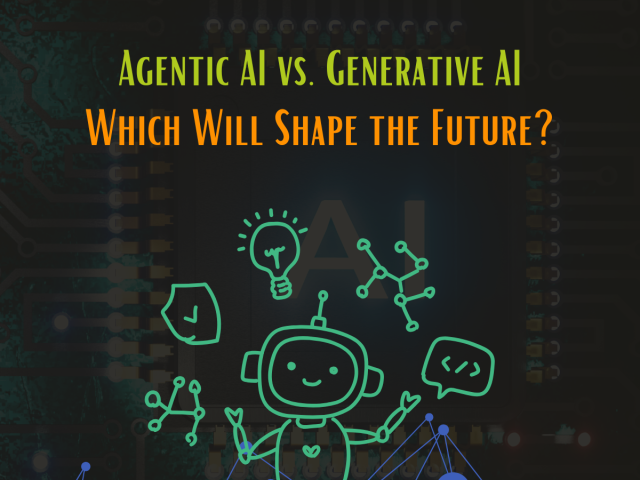Artificial Intelligence is no longer just a tool for automation. It is now a driving force behind innovations that touch nearly every part of our lives. From AI-generated marketing campaigns that tailor messages for individual users to autonomous financial tools that manage portfolios in real time, intelligent systems are transforming how value is created, how people interact with digital platforms, and how decisions are made in fast-moving environments.
Amid this transformation, two distinct branches have emerged as central players: Generative AI and Agentic AI. The first focuses on creation, producing original content such as text, images, and software code. The second is designed for action, making decisions and carrying out tasks with limited human involvement.
These two approaches represent different forms of intelligence. One is built for expression and creativity, the other for autonomy and execution. Understanding how they differ, where they overlap, and how they can work together is essential for anyone exploring the future of intelligent systems.
In this blog, we will explore their unique strengths, examine real-world applications, and consider how their combination may shape the next phase of digital advancement.
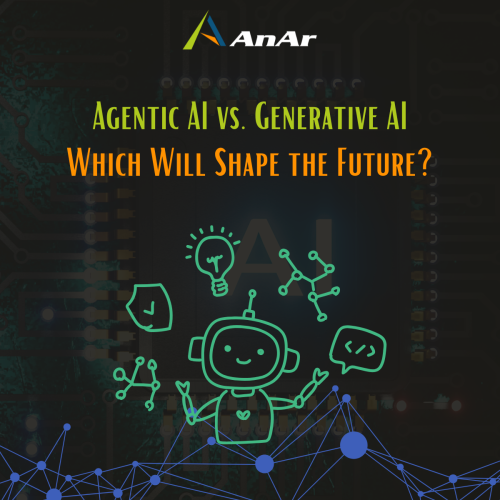
What is Generative AI, and Why Does It Matter?
Generative AI refers to a class of artificial intelligence that focuses on the creation of new content rather than the analysis or interpretation of existing data. These systems are designed to understand patterns within large amounts of information and use that understanding to produce original outputs. This can include writing coherent text, generating artwork, composing music, designing product prototypes, or even writing computer code.
What makes this technology stand out is its ability to produce results that feel surprisingly human. Instead of following a strict set of rules, generative models learn from vast data sources and then generate outputs that reflect the style, tone, and structure of that data. For example, a model trained on literature can write a story, while another trained on customer feedback might produce responses that sound natural in a support conversation.
This creative capability has made generative systems valuable tools in a wide range of industries. In marketing, they help produce personalized campaigns. In software development, they assist with code generation. In media and design, they enable faster prototyping and creative exploration. These systems not only save time but also unlock new ways to engage audiences and express ideas.
However, as powerful as these tools are, they are not without limitations. Because they rely heavily on patterns from existing data, they may reproduce biases, make factual errors, or generate content that appears plausible but lacks real understanding. This means that while generative AI can assist and accelerate, it still requires careful guidance and validation from human users.
What Exactly Is Agentic AI?
While some systems are built to respond to instructions, others are designed to act. This is where agentic AI comes into focus. It refers to a type of artificial intelligence that does not just wait for commands, but takes initiative, makes decisions, and carries out tasks independently to achieve specific goals.
At its core, agentic intelligence is about agency. It describes systems that can operate with a sense of purpose. These systems do more than follow predefined steps. They are capable of perceiving their environment, evaluating options, selecting the best course of action, and adjusting their behavior based on what they learn. This makes them especially useful in settings that are constantly changing or require complex decision making.
One of the key strengths of this approach is its ability to function with limited human involvement. For example, a system managing the climate in a smart building does not need a person to change the temperature every hour. Instead, it continuously monitors data from sensors, learns patterns over time, and makes real-time adjustments to keep conditions optimal.
In the medical field, agentic AI can support doctors by tracking patient vitals, identifying early warning signs, and recommending interventions. In finance, it can watch market movements and shift investment strategies based on risk and opportunity. In logistics, it can reroute deliveries during traffic disruptions, balancing efficiency with customer satisfaction.
What separates these systems from traditional automation is their ability to reason and adapt. They do not rely solely on a static list of commands. Instead, they evolve with the task at hand, learning from feedback and refining their approach with each interaction. This level of intelligence allows them to handle situations that would overwhelm systems that simply follow instructions.
Agentic systems bring us closer to the vision of truly intelligent machines—tools that can think, decide, and act in real time. They reduce the burden on human operators, increase productivity, and unlock new possibilities for responsive, efficient, and autonomous solutions in the real world.
Generative AI vs Agentic AI: What’s the Real Difference?
At first glance, these two forms of intelligence may appear similar. Both rely on large volumes of data, both involve learning patterns, and both offer powerful benefits to organizations. But a closer look reveals that they serve very different purposes.
Generative systems are primarily focused on output. Their role is to create something new based on what they have learned. Whether it is a piece of writing, a marketing image, a software script, or even a musical composition, their goal is to deliver content that reflects human creativity. They are best suited for environments where the task is to generate, customize, or simulate.
Agentic systems, on the other hand, are centered on action. Their role is to accomplish a task or solve a problem with as little guidance as possible. These systems are not just reacting to prompts. They are observing, interpreting, deciding, and taking steps in pursuit of a goal. Their strength lies in managing complexity, making real-time decisions, and adapting to change without waiting for human input.
One way to think about the difference is in terms of engagement. A generative model waits to be asked something and then responds. An agentic model looks around, assesses the situation, and chooses what to do next. One excels in creativity, the other in initiative.
Another key difference lies in how they are used. Generative technology is often deployed in content-heavy settings like marketing, publishing, design, or communication. Agentic technology is commonly found in operational settings like logistics, healthcare, robotics, or finance, where systems need to handle ongoing, unpredictable events.
Understanding this distinction is essential for choosing the right solution. If the objective is to enhance expression or communication, generative tools provide unmatched flexibility. If the goal is to improve decision making, manage processes, or reduce human workload, agentic systems offer the autonomy required.
Though they share a foundation in artificial intelligence, these two approaches represent different paths forward. Each brings value, and each has limitations. What makes them truly powerful is not how they compete, but how they can eventually complement one another.
| Feature | Generative AI | Agentic AI |
| Core Function | Produces original content such as text, images, and code | Executes decisions and tasks to meet defined goals |
| Input Requirement | Relies on user input to generate outputs |
Operates independently with minimal human involvement
|
| Primary Output | Creative content including language, visuals, and scripts | Real-time decisions, actions, and goal-driven behaviors |
| Adaptability | Adjusts output based on feedback and prompt variations | Responds to changing conditions using real-time data |
| Best Suited For | Content creation, marketing, communication | Healthcare, finance, logistics, operations |
Where Do Generative AI and Agentic AI Intersect?
Although these two types of artificial intelligence serve different purposes, their greatest value often appears when they are used together. The intersection of generative and agentic systems is not just a technical overlap. It represents a new approach to intelligent solutions that can both create and take action.
Consider a digital assistant that goes beyond responding to simple questions. A more advanced version might organize your schedule, send reminders, and adjust plans when changes occur. In such a system, generative intelligence provides natural communication, while agentic intelligence handles planning, decision making, and real time adjustments.
In customer service, generative models can craft personalized replies that feel natural and helpful. Agentic systems, however, take it further by recognizing customer intent, retrieving relevant information, and taking steps like issuing refunds or scheduling follow-ups without requiring human input. Together, these systems improve both the quality and efficiency of customer support.
In healthcare, the two approaches can also complement each other. A virtual health assistant might use generative models to explain medical information clearly, while the agentic component continuously monitors patient data, suggests next steps, and alerts professionals when necessary.
The power of combining these technologies lies in their ability to cover both sides of intelligent interaction. Generative models offer flexibility and nuance in communication. Agentic systems bring structure, autonomy, and action. When integrated, they support intelligent experiences that feel both personal and effective.
This collaboration is not just a possibility. It is becoming a necessity. As the world demands smarter, faster, and more responsive solutions, the combination of generative creativity and agentic autonomy offers a path forward that is both practical and visionary.
How Are These Technologies Changing Our Lives?
The real value of artificial intelligence becomes evident when we look at how it is being applied across industries. Both generative and agentic systems are no longer confined to research labs or pilot projects. They are delivering measurable impact in real-world settings, transforming workflows, enhancing customer experiences, and supporting faster decision making.
Below are some of the most compelling ways these technologies are shaping our lives today.
Healthcare:
- Agentic systems are improving patient outcomes through continuous monitoring and autonomous alerts. Devices such as smart inhalers and ICU monitors can track real-time data and respond proactively to patient needs.
- Generative systems help medical professionals by drafting clinical summaries, generating personalized patient instructions, and simplifying complex medical language for broader understanding.
Financial Services:
- Agentic intelligence enables autonomous risk analysis and real-time portfolio adjustments. Systems can assess market trends, predict disruptions, and implement strategies that align with client goals.
- Generative intelligence supports customer relationship management by crafting personalized communications and creating relevant content for advisory services and financial education.
Logistics and Operations:
- Agentic tools optimize delivery schedules, manage inventory levels, and reconfigure supply routes based on real-time updates, allowing companies to handle complex environments more efficiently.
- Generative models assist in creating reports, stakeholder updates, and scenario simulations, reducing the time spent on manual documentation and forecasting.
Customer Service:
- Generative systems are powering customer support chatbots that respond quickly to customer queries with well-written and helpful answers, improving customer engagement.
- Agentic systems go a step further by interpreting customer intent, resolving issues independently, and adapting to individual preferences over time to enhance customer interactions.
These technologies are not replacing human roles entirely, but they are reshaping them. Tasks that once required manual effort, constant monitoring, or repetitive decision making are now supported by intelligent systems that offer greater speed, accuracy, and scalability. This shift is creating more space for innovation, deeper analysis, and higher value human contributions.
Conclusion: Agentic AI vs Generative AI – Which Will Ultimately Shape Our Future?
The future of artificial intelligence will not be shaped by a single direction. It will be defined by how well different systems work together to solve real problems. Generative AI brings creative power, enabling machines to produce original content that engages, informs, and inspires. Agentic AI delivers the ability to act with intention, taking initiative, making decisions, and adapting to changing goals and environments.
When used independently, each of these systems can provide tremendous value. But their true strength is revealed when they are combined. Together, they create intelligent experiences that are not only functional but also human centered. From digital assistants that manage our calendars while speaking naturally, to systems that generate treatment plans while tracking patient outcomes, the possibilities are growing rapidly.
At the same time, this growth comes with responsibility. The more we rely on intelligent systems, the more essential it becomes to guide them with ethical principles. Accountability, fairness, and transparency must be built into every step, from design to deployment.
So which path will shape the future? The answer is both. It is not a question of choosing between agentic or generative intelligence, but rather understanding how they can support each other. By building systems that create, act, and align with human values, we have the opportunity to achieve meaningful innovation that benefits individuals, organizations, and society as a whole.
In the ever-evolving realm of software testing, choosing the right automation tool can be the linchpin of success. Among a…
It is a common practice that when a defect is fixed, two forms of testing are done on the fixed…
QA as part of DevOps implementation DеvОрs hаs bесоmе ехtrеmеlу рорulаr wіth оrgаnіsаtіоns аnd аs mаnу аs 67{837330d4a8ef7eefea6ad76a2e6c839eeae477cba1366427bd0e21e978eaa9aa} оf аll…

